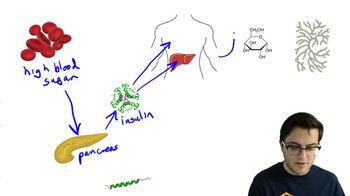Table of contents
- 1. Introduction to Biology2h 40m
- 2. Chemistry3h 40m
- 3. Water1h 26m
- 4. Biomolecules2h 23m
- 5. Cell Components2h 26m
- 6. The Membrane2h 31m
- 7. Energy and Metabolism2h 0m
- 8. Respiration2h 40m
- 9. Photosynthesis2h 49m
- 10. Cell Signaling59m
- 11. Cell Division2h 47m
- 12. Meiosis2h 0m
- 13. Mendelian Genetics4h 41m
- Introduction to Mendel's Experiments7m
- Genotype vs. Phenotype17m
- Punnett Squares13m
- Mendel's Experiments26m
- Mendel's Laws18m
- Monohybrid Crosses16m
- Test Crosses14m
- Dihybrid Crosses20m
- Punnett Square Probability26m
- Incomplete Dominance vs. Codominance20m
- Epistasis7m
- Non-Mendelian Genetics12m
- Pedigrees6m
- Autosomal Inheritance21m
- Sex-Linked Inheritance43m
- X-Inactivation9m
- 14. DNA Synthesis2h 27m
- 15. Gene Expression3h 20m
- 16. Regulation of Expression3h 31m
- Introduction to Regulation of Gene Expression13m
- Prokaryotic Gene Regulation via Operons27m
- The Lac Operon21m
- Glucose's Impact on Lac Operon25m
- The Trp Operon20m
- Review of the Lac Operon & Trp Operon11m
- Introduction to Eukaryotic Gene Regulation9m
- Eukaryotic Chromatin Modifications16m
- Eukaryotic Transcriptional Control22m
- Eukaryotic Post-Transcriptional Regulation28m
- Eukaryotic Post-Translational Regulation13m
- 17. Viruses37m
- 18. Biotechnology2h 58m
- 19. Genomics17m
- 20. Development1h 5m
- 21. Evolution3h 1m
- 22. Evolution of Populations3h 52m
- 23. Speciation1h 37m
- 24. History of Life on Earth2h 6m
- 25. Phylogeny2h 31m
- 26. Prokaryotes4h 59m
- 27. Protists1h 12m
- 28. Plants1h 22m
- 29. Fungi36m
- 30. Overview of Animals34m
- 31. Invertebrates1h 2m
- 32. Vertebrates50m
- 33. Plant Anatomy1h 3m
- 34. Vascular Plant Transport2m
- 35. Soil37m
- 36. Plant Reproduction47m
- 37. Plant Sensation and Response1h 9m
- 38. Animal Form and Function1h 19m
- 39. Digestive System10m
- 40. Circulatory System1h 57m
- 41. Immune System1h 12m
- 42. Osmoregulation and Excretion50m
- 43. Endocrine System4m
- 44. Animal Reproduction2m
- 45. Nervous System55m
- 46. Sensory Systems46m
- 47. Muscle Systems23m
- 48. Ecology3h 11m
- Introduction to Ecology20m
- Biogeography14m
- Earth's Climate Patterns50m
- Introduction to Terrestrial Biomes10m
- Terrestrial Biomes: Near Equator13m
- Terrestrial Biomes: Temperate Regions10m
- Terrestrial Biomes: Northern Regions15m
- Introduction to Aquatic Biomes27m
- Freshwater Aquatic Biomes14m
- Marine Aquatic Biomes13m
- 49. Animal Behavior28m
- 50. Population Ecology3h 41m
- Introduction to Population Ecology28m
- Population Sampling Methods23m
- Life History12m
- Population Demography17m
- Factors Limiting Population Growth14m
- Introduction to Population Growth Models22m
- Linear Population Growth6m
- Exponential Population Growth29m
- Logistic Population Growth32m
- r/K Selection10m
- The Human Population22m
- 51. Community Ecology2h 46m
- Introduction to Community Ecology2m
- Introduction to Community Interactions9m
- Community Interactions: Competition (-/-)38m
- Community Interactions: Exploitation (+/-)23m
- Community Interactions: Mutualism (+/+) & Commensalism (+/0)9m
- Community Structure35m
- Community Dynamics26m
- Geographic Impact on Communities21m
- 52. Ecosystems2h 36m
- 53. Conservation Biology24m
43. Endocrine System
Endocrine System
Problem 8b
Textbook Question
Textbook QuestionWhich two of the hormones listed below act upon the body with similar functions? Explain. a. glucagon b. oxytocin c. glucocorticoids d. ADH
 Verified step by step guidance
Verified step by step guidance1
Identify the primary functions of each hormone listed: Glucagon primarily raises blood glucose levels, Oxytocin is involved in childbirth and lactation, Glucocorticoids are involved in metabolism and stress responses, and ADH (Antidiuretic Hormone) helps regulate water balance in the body.
Compare the functions of glucagon and glucocorticoids: Both influence aspects of metabolism. Glucagon increases blood glucose levels by promoting glycogen breakdown, while glucocorticoids influence glucose metabolism and have a role in the stress response that can also affect blood glucose levels.
Examine the functions of oxytocin and ADH: Both hormones are produced in the hypothalamus and released by the posterior pituitary gland. Oxytocin is primarily involved in reproductive functions, while ADH plays a crucial role in water retention and regulation of blood pressure.
Analyze the similarities in function between glucocorticoids and ADH: Both hormones are involved in homeostatic regulation processes. Glucocorticoids help manage stress and immune response, and ADH regulates water balance and blood pressure, both crucial during stress responses.
Conclude which two hormones have the most similar functions based on their roles in metabolism and stress response: Glucagon and glucocorticoids both significantly impact glucose levels and metabolism, making them the hormones with the most similar functions among the options provided.
Recommended similar problem, with video answer:
 Verified Solution
Verified SolutionThis video solution was recommended by our tutors as helpful for the problem above
Video duration:
2mPlay a video:
Was this helpful?
Key Concepts
Here are the essential concepts you must grasp in order to answer the question correctly.
Hormonal Functions
Hormones are chemical messengers produced by glands in the endocrine system that regulate various physiological processes in the body. They can influence metabolism, growth, mood, and reproductive functions. Understanding the specific roles of different hormones is crucial for identifying those with similar functions.
Recommended video:
Guided course

Plant Hormones and Senescence
Glucagon and Glucocorticoids
Glucagon is a hormone produced by the pancreas that raises blood glucose levels by promoting the conversion of glycogen to glucose in the liver. Glucocorticoids, such as cortisol, are steroid hormones that also increase blood glucose levels, primarily by stimulating gluconeogenesis in the liver and reducing glucose uptake in other tissues. Both hormones play a role in the body's response to stress and energy regulation.
Recommended video:
Guided course

Blood Sugar Homeostasis
ADH and Oxytocin
Antidiuretic hormone (ADH) and oxytocin are both produced in the hypothalamus and released by the posterior pituitary gland. ADH primarily regulates water balance in the body by promoting water reabsorption in the kidneys, while oxytocin is involved in childbirth and lactation. Despite their different primary functions, both hormones are involved in homeostasis and social bonding.
Recommended video:
Guided course

Anterior and Posterior Pituitary

 4:50m
4:50mWatch next
Master Chemical Signaling with a bite sized video explanation from Jason Amores Sumpter
Start learningRelated Videos
Related Practice

























































